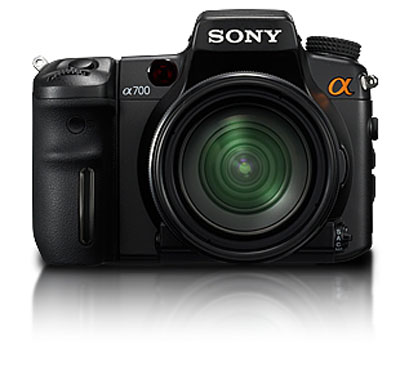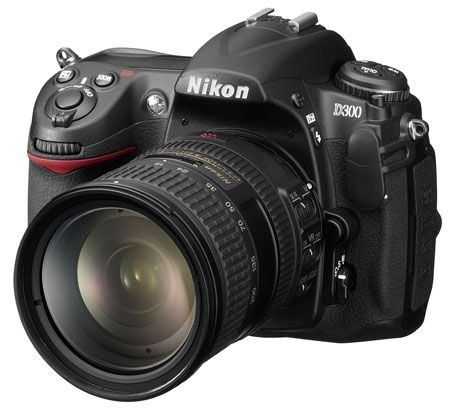Digital Camera Buyers' Guide - Year of the SLR
by Wesley Fink on November 23, 2007 6:00 AM EST- Posted in
- Digital Camera
Prosumer SLRs
It seems everyone is introducing new prosumer models. Understanding what's hot in this market of hard-to-please photography buffs will help you know what to look for in an entry-level camera. If you're in the market for one of these advanced amateur DSLRs, you may want to pay closer attention.

Sony started this prosumer round, just as they started the 10 megapixel (MP) round last year. The new top-of-the-line Sony is now their $1400 A700. Those who doubted that Sony was in the digital SLR market to win were greeted with a slick, stylish, and very fast 12.2MP DSLR with image stabilization, auto dust cleaning, a 3" hi-res LCD, 5.0FPS shooting, and new Sony brand lenses. Conspicuously absent is Live View, a feature pioneered by Olympus on DSLR cameras that allows the user to see through the lens on the LCD. This is standard fare on a point-and-shoot, but difficult to do with the "through-the-lens" optical viewing that is a feature of SLR technology.

Because they are so huge and influential in the photo market, Canon prosumer models receive lots of scrutiny. The new Canon model is the 40D, which continues the 20D/30D models that have defined the Canon prosumer DSLR. The 30D is 8MP and the 40D raises that to 10MP. Many expected an even higher-resolution 40D, but instead the 40D features the same 10MP resolution seen in the entry-level Canon XTi for the past year. New for the $1300 40D is much faster auto-focus, a 3" LCD replacing the 2.5", dust cleaning on startup, dust sealing, and Live View - a first for Canon. There are many other improvements, but they refine existing features of the Canon line.

Nikon announced - but has not shipped - the new D300, which is an update to the D200. The D200 got lost in the wake of the entry-level D80 last year. Nikon uses Sony sensors with their own electronics, and it appears the new D300 uses the same Sony 12.2MP CMOS sensor with on-sensor noise reduction found in the Sony A700. The D300 will launch at a street price of about $1800. The D300 also features a 3" hi-res LCD, very fast autofocus, Nikon's first auto sensor-cleaning system, 6FPS shooting, dust/splash sealing, and Live View.

Olympus has come to life recently, just when many had all but given up on them. Always the innovator, Olympus pioneered auto dust cleaning and Live View on digital SLR cameras based on their "digital-only" 4/3 standard. However, the Olympus 4/3 system was getting very long in the tooth, with a 5.5MP pro model E-1 introduced in 2003. Olympus has just started shipping their new E-3 flagship, which thoroughly updates the Olympus system.
Olympus says the E-3 is their pro model, and it features dust and splash sealing for both the E-3 body and pro lenses. The E-3 also introduces the first new AF module for Olympus in many years. The new AF, which was long overdue, features 11 cross-type sensors, each on two planes, for a total of 44 segments. According to Olympus, the result is the fastest auto focusing SLR you can buy when used with their new SWD (Sonic Wave Drive) lenses, such as their new 12-60mm f2.8-4.0 (24mm-120mm equivalent). The street price of $1699 is much less expensive that the $5000+ entry price for Nikon and Canon pro models. Many, however, feel the real competition for the E-3 is the "prosumer" Nikon D300 and Canon 40D.
The E-3 is also the first Olympus pro model to feature built-in flash, and it's dust and splash sealed. Auto sensor cleaning is a feature, image stabilization is built in and works with all lenses, and the latest incarnation of Live View with a fold out articulating LCD screen is featured. The LCD screen is 2.5", and not the 3" screen of competing models, but competing models don't have a flip-out LCD. Resolution is 10MP, but the E-3 supports ISO-3200 and it is definitely the low-noise camera many didn't think was possible with the smaller 4/3 sensor.
Canon ditched their FD breech mount years ago when they first introduced the EOS autofocus system. That risky move has paid off handsomely for Canon with their current line of all electronic, lens-motor driven lenses. Olympus took a similar tact by ditching their OM mount for an all-electronic mount for digital cameras. However, Olympus didn't have the influence of a Canon when they championed a smaller 4/3 standard sensor and claimed that lenses needed different designs for best digital performance. This was regarded by most of us as marketing-speak, but recent reviews of Olympus glass are showing their 4/3 lens designs - even their cheap kit lenses - do have less light fall-off and are generally sharper in digital photography than competing systems using APS-C or 35mm lenses.

The bottom line is the E-3 and recent Olympus lenses like the pro 14-35 f2.0 zoom (equivalent 28-70mm) and the tiny, cheap, but excellent quality 40-150mm (equivalent 80-300) f4.0-5.6 kit lens may finally gain Olympus the respect in the digital SLR market that has eluded them up to now.










74 Comments
View All Comments
Wesley Fink - Tuesday, November 27, 2007 - link
I'm sure the answer to a better Photo Editor would be you. We understand you are disappointed that Anand did not hire you to write for AT, but the years of criticizing the Editors he did choose to hire is getting very tiring. You really need to get over it and move on.KorruptioN - Tuesday, November 27, 2007 - link
Burn.strikeback03 - Monday, November 26, 2007 - link
The Sigma lenses for 4/3 are not designs purely for 4/3 as the Oly lenses are - they are mount adaptations of existing lenses such as the Bigma.Some notes on the different implementations of AF in Live View between the different manufacturers might have been useful, as well as noting that the best AF performance will still be obtained through use of the real viewfinder.
Finally I agree with the need to go physically try a camera before buying. For example the reviews at DPReview typically complain about the grip of the 400D/XTi, while praising the A100. However I find that the 400D is much more comfortable as my pinkie just curls up below the body, while on the A100 the grip is too long to do that, but too short for the pinkie to actually grab, so my pinkie just kinda hangs in space.
melgross - Monday, November 26, 2007 - link
[quote]The Sigma lenses for 4/3 are not designs purely for 4/3 as the Oly lenses are - they are mount adaptations of existing lenses such as the Bigma. [/quote]That's correct.
As far as I'm concerned, the 4/3 system, which I was initially excited about upon its announcement, is not worth the long term purchase of the equipment.
Olympus could have used the image circle of the APS C sensor for a larger image sensor, which could have been done, but chose not to. So, instead of having a magnification of possibly 1.4 to 1.3x, it's 2x. A poor choice. Also, if they hadn't done that, all APS C sensor lenses would have the same magnification as Olympus's lenses, and better S/N, rather than worse.
As they made no concession to size when designing the cameras and lenses for this system, there is no advantage there either.
It seems to be a bastard system to me, and conveys no advantage.
frombauer - Monday, November 26, 2007 - link
... the largest (or tiniest) problem with 4/3 cameras like the Olympus. The ridiculously small and dim viewfinder. It's like looking through a small tunnel. Simply not practical. Just looking at any Nikon or Canon VF makes a world of a difference. I'm not even talking about the 5D.Wesley Fink - Monday, November 26, 2007 - link
I generally agree, and even the Pro E-1 was pretty small and dim. However,Look throught the E-3 viewfinder with a standard 1.15x viewfinder. I suspect any doubts that a 4/3 viewfinder can be huge, bright, and very easy to use will disappear. It took a few years but the E-3 viewfinder is definitely a huge leap forward for the 4/3 system.Johnmcl7 - Saturday, November 24, 2007 - link
The Digilux 3 is the Leica branded version of the Panasonic DMC-L1 and they're both relatively hefty cameras when compared to the smaller E-410/E-510 cameras or even their Olympus sibling the E-330. Although not anywhere near as big as something like the 5D, the Digilux 3 is bigger than the E-510.The Digilux 2 was a smaller camera (Leica version of the Panasonic LC-1) which may be the one you're thinking of although this wasn't an SLR despite the similarity in design to the L1/Digilux 3.
Also, the E-3 doesn't have a lens cleaning feature:
"The E-3 is also the first Olympus pro model to feature built-in flash, and it's dust and splash sealed. Auto lens cleaning is a feature, image stabilization is built in and works with all lenses, and the latest incarnation of Live View with a fold out articulating LCD screen is featured."
I assume you're referring to the sensor cleaning feature?
This section refers to the E-510 having multiple cross type sensors:
"However, the autofocus is still a weakness in an otherwise very capable system. It uses the somewhat dated 3-point autofocus, but cross sensors provide for greater sensitivity. "
Or at least that's how I read it, of the three AF points only one of them is a cross type (the centre one) while the other two are vertical only.
John
Johnmcl7 - Saturday, November 24, 2007 - link
...turns out it was posting them despite it erroring and not showing initially...Wesley Fink - Saturday, November 24, 2007 - link
Yes I was thinking of the 2 as they long similar. Thanks for the info. I have corrected the reference.Johnmcl7 - Sunday, November 25, 2007 - link
Thanks for the correction, the other errors (E-3 lens cleaning and E-510 AF) are still there though.John